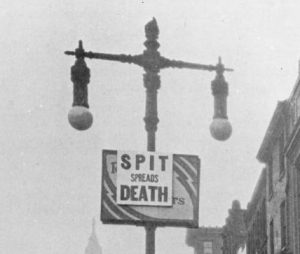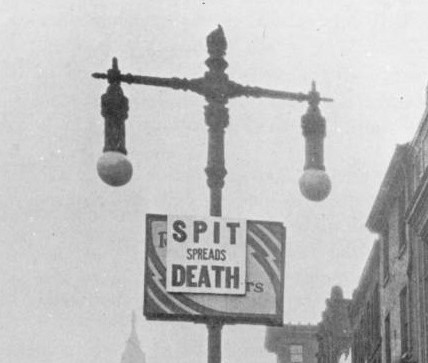Influenza (“Spanish Flu” Pandemic, 1918-19)
By Thomas Wirth | Reader-Nominated Topic
Essay
As World War I drew to a close in November 1918, the influenza virus that took the lives of an estimated 50 million people worldwide in 1918 and 1919 began its deadly ascent. The United States had faced flu pandemic before, in 1889-90 for example, but the 1918 strain represented an altogether new and aggressive mutation that proved unusually resistant to human attempts to curb its lethality. The devastating effects of the virus, known today as H1N1, were first felt in late summer 1918 along the eastern seaboard in a military encampment outside of Boston. From there, influenza propagated ruthlessly across the country, claiming nearly 700,000 lives before running its course in the spring and summer of 1919.
The pandemic hit Philadelphia exceptionally hard after sailors, carrying the virus from Boston, arrived at the Philadelphia Navy Yard in early September 1918. In a city of almost two million people, a half a million or more contracted influenza over the next six months. Equally as startling, over 16,000 perished during this period, with an estimated 12,000 deaths occurring in little more than five weeks between late September and early November 1918. Historians and epidemiologists have identified several critical factors that shaped Philadelphia’s experience with influenza and help explain the peculiarly rapid and catastrophic spread of disease.
First, a severe shortage of medical personnel rendered the city partially defenseless against the pandemic. More than 25 percent of Philadelphia’s doctors, some 850 total, and an even greater share of its nurses were occupied with the war effort. In 1917 and 1918, three-quarters of the staff of Pennsylvania Hospital at Eighth and Spruce Streets was stationed at the Red Cross Base Hospital 10 in Le Tréport, France. Over two dozen physicians, fifty nurses, and nearly 200 aid workers with hospital training were called overseas, depriving the city of a skilled group of men and women on the eve of the pandemic. The absence of vital medical support made the difficult task of containing the flu and healing the sick even more challenging once the virus migrated from the military camps—including the Navy Yard, Camp Dix in New Jersey, and Camp Meade in Maryland—to the civilian population in late September.
Overcrowding’s Toll
The increased demand for labor during the war also compounded matters. While Philadelphia enjoyed a fantastic boom in employment in its shipbuilding, munitions, and steel industries, overcrowding turned the city’s well-documented but often ignored housing deficiencies into a legitimate public health crisis. As African American migrants from the Jim Crow South and immigrants from eastern and southern Europe fled their miserable circumstances in search of a better life, many found the opportunities gained in Philadelphia came at the price of their health and safety. Cramped, dilapidated, and unsanitary living quarters in places like the Seventh Ward—home to a third of the city’s African Americans in 1918—made the slums and tenement districts a fertile source for influenza.
If the city’s execrable living conditions and depleted medical corps made suppressing influenza difficult, its unabated proliferation in the fall of 1918 likely had its origins in the response of city health officials who drastically underestimated the flu’s potency. On September 21, just days after 600 sailors at the Navy Yard fell ill and the first civilian flu cases were confirmed, Philadelphia’s major newspapers reported that Dr. Paul A. Lewis of the Henry Phipps Institute at the University of Pennsylvania had determined the cause of the disease—a bacteria known as Pfeiffer’s B. influenzae. The Philadelphia Inquirer wrote that Lewis’s findings had now “armed the medical profession with absolute knowledge on which to base its campaign against the disease.”

The city’s top health administrators concurred and yet promptly contradicted their own best advice for staving off the grippe: avoid crowds. With virtually no resistance from the city’s leading public health officials at the Department of Public Health and Charities, a rally for the Fourth Liberty Loan Campaign brought 200,000 Philadelphians together into the city’s streets on September 28. A concert at Willow Grove Park featured the music of John Philip Sousa, stoking patriotic fire. Philadelphia raised $600 million in war bonds as a result, but this success immediately revealed a Faustian bargain. Within three days of the event, 635 new civilian cases of influenza signaled the beginning of the single most deadly period of pestilence ever recorded in the city’s history.
Influenza tore through Philadelphia at a ferocious pace in October and early November. During the second week of October 2,600 people succumbed to the flu, and the following week saw that number nearly double. Though the disease knew no gender, racial, or ethnic boundaries, infecting black and white men and women at an equally high rate, the city’s immigrant poor suffered hard. Those born of foreign parents in the Russian, Hungarian, and Italian communities, among others, died at a higher rate, with some 1,500 more total deaths than those born to American mothers. In a war time atmosphere on the eve of the Red Scare, immigrants were the primary target of inflamed nativist sentiment. Public health officials and private citizens alike scrutinized the personal hygiene habits of the foreign born and often linked insalubrious tendencies to the supposedly questionable morals associated with “alien” cultures. One “disgusted woman” wrote to the Public Ledger in October 1918 demanding that “don’t-spit signs be placed in our post-office building in all languages necessary, to reach all foreign men, and with fines for violations.” The city set fines for spitting at $2.50 and in one day, October 23, the Evening Bulletin reported 114 arrests.
Deluge of Corpses
As death stalked the city, unembalmed bodies piled up by the dozens in a lone morgue at Thirteenth and Wood Streets. The extreme circumstances of the pandemic also meant, however, that many bodies simply rotted for days in the streets. Eventually five makeshift morgues, including one at a cold-storage facility on Cambridge and Twentieth Streets, were established to meet the deluge of corpses. Cemeteries lacked the space and manpower to adequately bury the dead, too. At Holy Cross Cemetery in Lansdowne seminarians turned grave-diggers took in an average of 200 bodies a day in October and deposited hundreds of coffins into a large common grave. “On one occasion,” recalled Reverend Thomas C. Brennan of St. Charles Borromeo Seminary, “the students worked on this task until 10:30 p.m. by the light of the October full moon, the long rows of coffins in the trench presenting a weird and impressive picture in the moonlight.”
Those attempting to care for the living at Philadelphia General Hospital on Thirty-Fourth Street faced similarly overwhelming circumstances. Already at its capacity of 2,000 patients when the virus struck, the hospital had to find room for 1,400 more people as it peaked in mid-October. With hospitals inundated and facing a shortage of medical staff, volunteers were culled from religious organizations, civic associations, and, most prominently, the city’s medical and nursing schools. Across Philadelphia these men and women turned parish houses and armories into temporary emergency hospitals, but on the whole extra assistance remained scarce. As one volunteer recalled, “if you asked a neighbor for help, they wouldn’t do so because they weren’t taking any chances…It was a horror-stricken time.” And yet just as quickly did the horror arrive did it also depart. When 10,000 dosages of a flu vaccine finally arrived in Philadelphia on October 19, the virus was already in the beginning stages of a rapid decline. By the second week of November, deaths caused by influenza and pneumonia were less than a quarter of what they were the week prior, and by the end of the month the death toll had dipped under 100 for the week for the first time since early September. Still, the city’s death rate from influenza, at approximately 407 per 100,000 people, exceeded that of all other American cities in 1918.
Statistics such as these provide a tangible sense of the staggering loss of life that occurred in Philadelphia during this short period, though tell us next to nothing about how influenza inflicted widespread fear and distress across the city. For an instant in the fall of 1918 it was as if Philadelphia had been transported back to the fourteenth century to that grisly time when victims stricken with plague were often found dead within twenty four hours of contracting it. Perhaps the words of the renowned cardiologist Isaac Starr, a third-year medical student at the University of Pennsylvania at the time of the outbreak, came closest to encapsulating the ordeal of late 1918 when he noted simply that it was as if “the life of the city had almost stopped.”
Copyright 2011, University of Pennsylvania Press
Gallery
Backgrounders
Connecting Headlines with History
Links
- Philadelphia News Coverage of the Epidemic (Influenza Encyclopedia, University of Michigan)
- Newspaper clipping, 1920: "Prohibition guards against influenza" (Drexel University College of Medicine Legacy Center)
- The Deadly Virus (National Archives Online Exhibit)
- American During the 1918 Influenza Epidemic (Exhibit, Digital Public Library of America)
